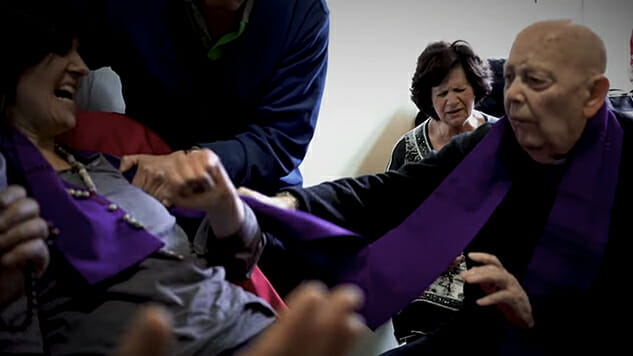The Devil and Father Amorth

Admittedly, if the mind truly believes that a demon, or even the devil himself, has taken over one’s soul, being surrounded by spiritual professionals and a group of other believers working overtime to cast Satan out might show actual physical results. Not a red dude with horns invisibly slithering out of someone’s body, but some sort of psychological solace in the form of spiritual interference. Just look at Italy: Every year, over half a million people there seek the services of an exorcist. If these sessions didn’t yield results, why is the demand so high?
Before his recent passing, Father Gabriele Amorth was the superstar of exorcisms in Italy. It’s not surprising that his favorite film was The Exorcist, which spurred on a friendship between Amorth and director William Friedkin. Amorth trusted Friedkin so much that he allowed him to film one of his exorcisms, the ninth attempt, in particular, to exorcise the devil out of a woman who’s seemingly suffering from some major neurological disorder. Make no mistake, the 20-minute chunk of raw footage that lands square in the middle of this barely-over-one-hour feature is the main reason for this film to exist.
First, Friedken explores the origins of The Exorcist. Anyone who’s seen even one of the hundreds of documentaries about the making of that classic—the story of that production, from inception to release, is pretty much ingrained in everyone’s heads by now—will not find anything new here.
From there, we jump to the main attraction. Friedkin wasn’t allowed any other crew member to film the exorcism session, so the whole thing looks like rehearsal footage, complete with auto focus adjusting every couple of minutes. This raw presentation, without any background music or sound and visual effects, is what makes the experience so chilling. That said, it’s hard to sell a 20-minute home video of a priest and a bunch of believers in a small hospital room continuously yelling at “the devil” to leave the body of a woman who’s screaming and struggling for dear life, so Friedkin pads the runtime with interviews with priests and neurologists, though he knows that the meat of his film is the exorcism footage, leaving the rest underdeveloped. Just when you think the discussions are penetrating some interesting medical meeting point between science and religion, Friedkin cuts to yet another detail about the exorcism video. It bears an overall feeling that we’re watching a work in progress.